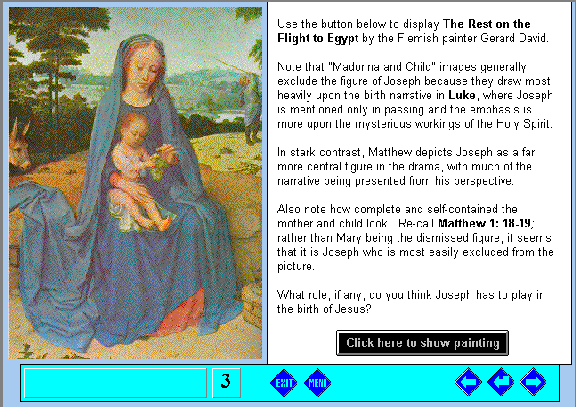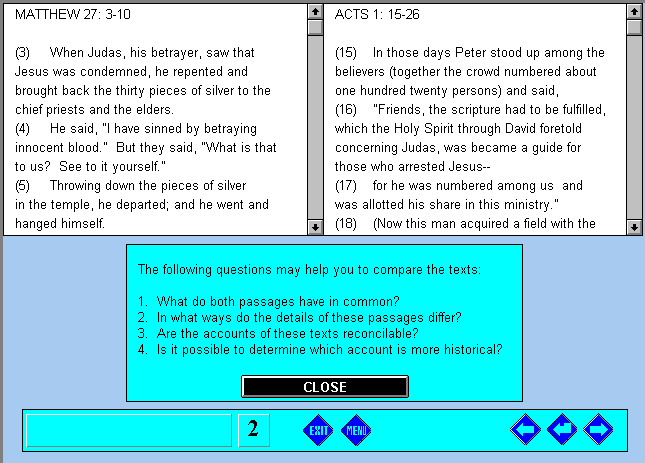
Preparation for a seminar on the birth of Jesus.
| Computers & Texts No.13 |
Table
of Contents | December 1996 |
Alan Ford
Department of Theology
Barabra Watson
Information Technology Services
University
of Durham
Hypertext courseware on 'Graeco-Roman Culture and the Rise of Christian Faith' was integrated into the first-year New Testament module in the Department of Theology at the University of Durham. The courseware provides basic background information to enable students to interpret theological texts through questions and links to reference material. The students study these computer aided learning (CAL) materials in preparation for their seminar discussions. The aim of the CAL is to enhance the students' understanding and improve the quality of essays and tutorial discussions.
The development of courseware was made possible through funding obtained from the Teaching and Learning Initiatives Fund of the University of Durham. This fund supports appropriate teaching and learning initiatives that cannot reasonably be funded from other internal sources. The application was made by the Department of Theology in collaboration with the Teaching and Learning Technology (TLT) Section of the Information Technology Service. The TLT Section offers a central service to departments by providing advice, information and courseware development. The aims of the TLT team are to encourage, support and develop the use of Inform-ation Technology (IT) in teaching and learning throughout the University.
The funding was used to buy hardware and software, and to employ a research assistant for three months to develop the CAL materials. The research assistant appointed was a Theology graduate, which had the advantage of the developer being able to understand the academic content of the CAL and research the hypertext links. Although not an experienced computer user, following training from TLT staff, the developer quickly became familiar with the Windows environment and learnt how to program in Asymetrix ToolBook. TLT also supported the design, development of the CAL and installation on the campus-wide Novell network.
The course curriculum was reviewed and the learning objectives analysed in order 'to achieve the pedagogical potential and offer a new kind of learning experience to students' (Laurillard, 1995). Laurillard's analysis of educational media in supporting the different aspects of the teaching-learning process shows that 'tutorial simulation' comes closest to providing complete support for the independent learner (Laurillard 1993).
Teachers involved in teaching the first year New Testament course in the Theology Department had expressed concerns about the ability of first year students to read and understand texts and make a meaningful contribution to discussion at seminars. The courseware was designed to enable students to compare texts by placing them in juxtaposition on the screen, using interactive questions to encourage the student to analyse their meaning and context. The use of hypertext enables the student to see the relationships between different texts and form relations between abstractions to develop the conceptual models required for understanding (Johnson-Laird 1983). On some screens, students click on buttons which highlight the relevant words in the text to illustrate particular viewpoints. Hints were provided to some questions but these were designed to be available only after the students had seen the questions, to provide the guided discovery mode of learning which is 'the richest mode of learning' (Laurillard 1995). This CAL package aims to develop 'progressive mental model construction toward a certain model structure' (Schnotz 1995), through appropriate presentation of text, hyperlinks, and questions.
This courseware was integrated into the module through a supervised introductory session in a computer classroom. The lecturers subsequently advised the students about which sections of the CAL material they should study in preparation for their seminar discussions. This follows Atkins' suggestion that '. . .a human tutor may still be needed to extend the thinking of that group' (Atkins 1993). Perhaps predictably, the most difficult aspect of integration was not securing the co-operation of the students, but in ensuring that staff taking the seminars made sure that they had adequately familiarised themselves with the CAL material before hand, so that they could be aware of the specific knowledge and background that students had acquired through the programme.
Whilst the main focus of the programme was upon the seminars, and trying to improve students' ability to read and discuss the texts, in an effort to provide an additional incentive to use and reuse the CAL material, particular care was also taken to ensure that the texts were closely linked to the course essays, which formed part of the assessment of the module. As a result, students also used the material after the seminars when writing their essays and when preparing for the examinations which formed the other part of the assessment.
 | Preparation for a seminar on the birth of Jesus. |
Sixty-one students completed a questionnaire at the end of the supervised computer session.
The results showed that initially the students had a wide range of computing skills as 15% had no computer experience and 36% had more than 2 years. Generally, they did not have any problems with using the package as 83% found the text easy or very easy to read, 90% found the instructions easy or very easy to follow and 74% found navigating from one part of the application to another easy or very easy. Only one student needed help from the lecturer or a colleague most of the time when using the computer.
The hypertext materials also appeared to improve the students' understanding of the theological content as 88% of the students thought that using the package enhanced their learning. 76% and 78% thought the material was helpful or very helpful for seminar or essay preparation, respectively. The CAL also motivated the students to learn as 87% of the students had enjoyed working through the lessons and all of the students, except one, liked the self-paced learning, the ability to repeat the work and the access to the mat-erials at any time.
Whilst it is as yet early to assess the overall impact of the program, the modules teachers have reported an initial impression that the quality of seminar discussions has improved in a number of ways:
In addition, though the CAL materials did little to (and were not intended to) stretch or improve the skills of those already familiar with computers, they proved extremely useful in introducing and instilling confidence into those students who had little experience of computers or who were somewhat apprehensive about their use. The requirement to register with the University IT Service before the course, and the basic computer skills that were taught at the introductory session proved an essential springboard for further exploration for those who might otherwise have not used the central computing network.
Whilst happy with the success of the project, certain caveats must be entered. Bringing it to a successful conclusion required close co-operation between the TLT team, academic staff and the research assistant. Much in particular depended upon the intellectual quality, academic and computing skills of the research assistant. Given the impossibility of securing a candidate with that rare blend of skills, ability to programme in ToolBook OpenScript and a ready knowledge of the Durham undergraduate Theology course, a decision was taken at an early stage to opt for a research assistant with theological skills. This proved immensely beneficial in ensuring that the programme made sense pedagogically and could relate to the needs and skills of first year undergraduates. But it slowed down progress considerably in the initial stages as the assistant learnt the necessary computing and programming skills. Since employment was for a three month period only, and the assistant subsequently left to pursue doctoral research elsewhere, those skills are now lost to the department.
Close acquaintance with the task of designing and programming the package has left the academics involved convinced that, given current constraints on their time (and energy and enthusiasm), it would not be feasible for them to learn OpenScript and write further programmes themselves. Thus while remaining convinced both of the positive impact of the CAL programme on the teaching of this module, and of the need to extend it to other similar courses, funding constraints, which prevent the employment of another programmer, have prevented any immediate follow-up.
Finally the inflexibility or, to be more accurate, the precise and specific focus of the material means that it is only really applicable for the particular course for which it was designed, and for the particular teachers who are teaching that course.
It was hoped that the use of CAL would increase the students' enthusiasm for the subject and improve the quality of discussions. Preliminary results suggest that this is indeed the case.
The academics concerned remain convinced that further CAL packages would be of immense benefit to the teaching of other text based courses, though funding cutbacks make it unlikely that this avenue will be pursued in the near future.
 | Using the Durham Theology CAL Software to compare texts on the death of Judas. |
Atkins, M. J. (1993). 'Evaluating interactive technologies for learning'.
Journal of Curriculum Studies 25: 4, 333-342.
Johnson-Laird, P. N. (1983). Mental Models. Cambridge:
Cambridge University Press.
Laurillard, D. (1993). Rethinking
University Teaching. London and New York: Routledge.
Laurillard D. (1995). 'Multimedia and the changing experience of the
learner'. British Journal of Educational Technology 26: 3, 179-189.
Schnotz, W. and A. Preuss, (1995). 'Task-dependent construction of
mental models as a basis for conceptual change'. Research Report No 6. Jena:
University of Jena.
Further information and copies of this programme can be obtained by contacting Barbara Watson, Information Technology Service (B.A.Watson@durham.ac.uk) or Alan Ford, Department of Theology (G.A.Ford@durham.ac.uk).
[Table of Contents] [Letter to the Editor]
Computers & Texts 13 (1996), 2. Not to be republished in any form
without the author's permission.
HTML Author: Michael
Fraser (mike.fraser@oucs.ox.ac.uk)
Document Created:7 January 1996
Document
Modified:
The URL of this document is
http://info.ox.ac.uk/ctitext/publish/comtxt/ct13/ford.html